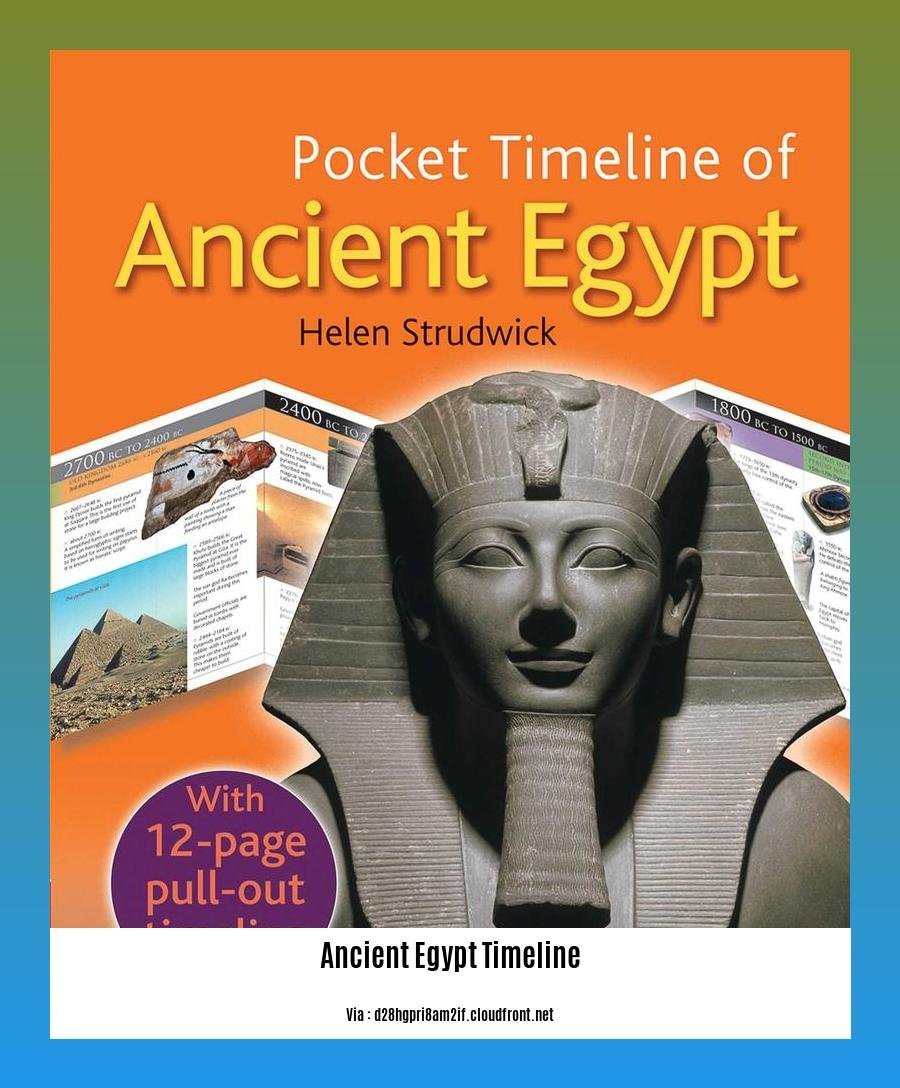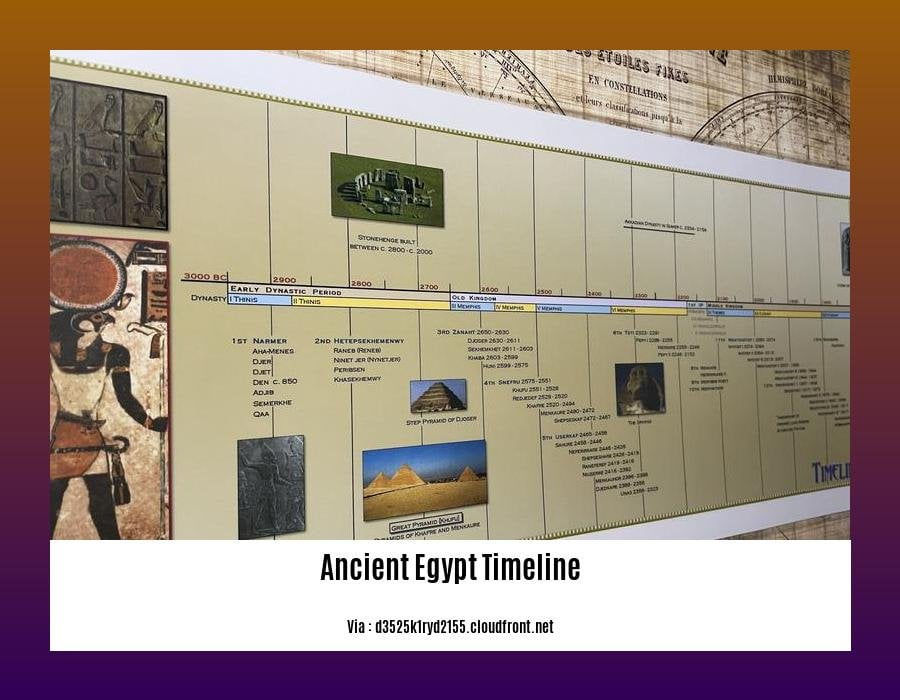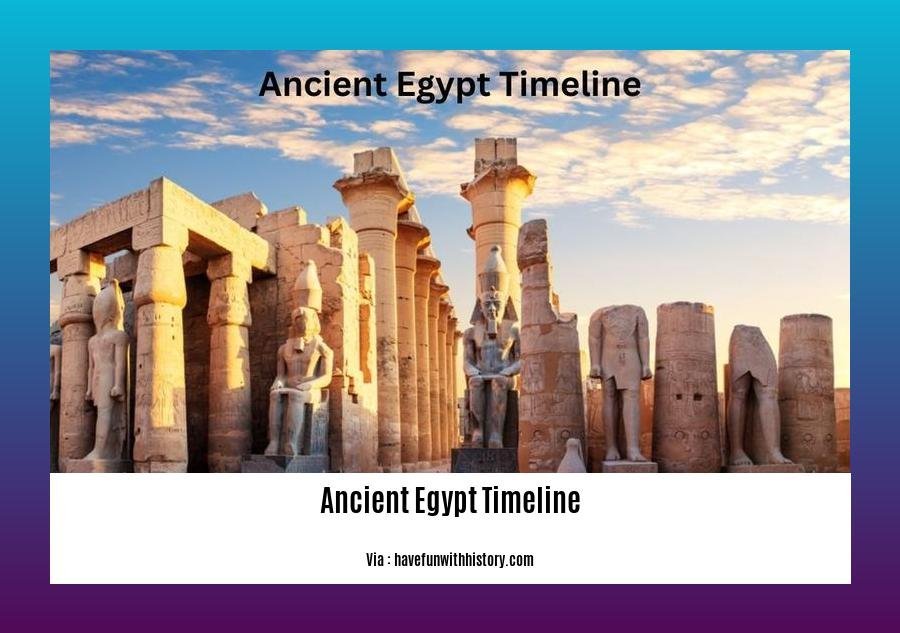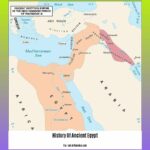Embark on a captivating journey through time as we delve into the [Ancient Egypt Timeline: Uncovering the Chronological Tapestry of a Legendary Civilization]. Explore the enigmatic dynasties, legendary rulers, and pivotal events that shaped the course of one of history’s most extraordinary civilizations. Through meticulous research and firsthand exploration of archaeological wonders, this timeline unravels the intricate tapestry of ancient Egypt, painting a vivid picture of its rise, reign, and enduring legacy.
Key Takeaways:
- Ancient Egypt’s history is divided into distinct periods, beginning with the Predynastic Period (ca. 4300-3000 B.C.E.) before unification.
- The Early Dynastic Period (ca. 3000 – 2675 B.C.E.) marked the unification of Egypt and the establishment of Memphis as the capital.
- The Old Kingdom (ca. 2675 – 2130 B.C.E.) witnessed the height of centralized power and the construction of iconic structures such as the Great Pyramids.
- Periods of decentralization and instability occurred during the First Intermediate Period (ca. 2181-2055 B.C.) and the Second Intermediate Period (ca. 1786-1567 B.C.).
- The Middle Kingdom (12th Dynasty ca. 2055-1786 B.C.) restored unity and expanded the empire.
- The New Kingdom (ca. 1567-1085 B.C.) marked a period of military conquests and cultural achievements.
- Periods of instability and foreign rule followed during the Third Intermediate Period (ca. 1085-664 B.C.) and the Late Period (ca. 664 – 332 B.C.E.).
- The Macedonian Period (ca. 332 – 305 B.C.E.) saw the conquest of Egypt by Alexander the Great.
- The Ptolemaic Dynasty (ca. 305 – 30 B.C.E.) was a Hellenistic dynasty founded by one of Alexander’s generals.
Ancient Egypt Timeline

Unraveling the chronological tapestry of ancient Egypt unveils a captivating narrative of dynasties, rulers, and significant events. Let’s embark on a journey through this extraordinary civilization’s timeline:
Predynastic Egypt (c. 5000-3100 BCE)
- Neolithic communities thrived along the Nile, giving rise to settled societies.
- Cultures like Fayum, Badari, and Naqada laid the foundation for Egypt’s future grandeur.
Archaic Period (c. 3100-2686 BCE)
- Narmer unified Upper and Lower Egypt, marking the ancient Egypt timeline’s beginning.
- The First Dynasty established Memphis as the capital, fostering the birth of hieroglyphics.
Old Kingdom (c. 2686-2181 BCE)
- Monumental pyramids at Giza symbolized the grandeur of Pharaohs Khufu, Khafre, and Menkaure.
- A centralized bureaucracy flourished, shaping the nation’s administration.
First Intermediate Period (c. 2181-2055 BCE)
- Political upheaval fragmented Egypt, leading to regional power struggles.
- Artistic and architectural quality declined as the Old Kingdom’s legacy faded.
Middle Kingdom (c. 2055-1650 BCE)
- Mentuhotep II reunited Egypt, ushering in a renaissance of power and prosperity.
- Pyramids and temples at Thebes showcased the empire’s resurgence.
Second Intermediate Period (c. 1650-1550 BCE)
- Invasion and rule by the Hyksos introduced new technologies and warfare into Egypt.
- The Hyksos dynasty left a lasting impact on Egyptian military and weaponry.
New Kingdom (c. 1550-1070 BCE)
- Liberation from Hyksos rule marked the New Kingdom’s rise.
- Pharaohs like Thutmose III and Akhenaten expanded Egypt’s empire and left an enduring cultural legacy.
Third Intermediate Period (c. 1070-664 BCE)
- Division into northern and southern kingdoms weakened Egypt’s unity.
- Foreign influences, such as the Libyan dynasty, shaped this period.
Late Period (c. 664-332 BCE)
- Assyrians conquered Egypt, bringing foreign rule.
- Saite and Persian dynasties left their mark, shaping the country’s culture and politics.
Greco-Roman Period (c. 332 BCE-641 CE)
- Alexander the Great’s conquest opened Egypt to Hellenistic influences.
- The Ptolemaic dynasty ruled Egypt until its eventual absorption into the Roman Empire.
As we traverse the ancient Egypt timeline, we witness the rise and fall of empires, the creation of monumental architecture, and the unfolding of a rich cultural tapestry that continues to captivate and inspire us today.
Delve into the history of ancient Egypt, where you’ll unearth the captivating story of one of the world’s oldest civilizations. Embark on a journey through the annals of egyptian civilization history and discover the grandeur of the pharaohs’ reigns by exploring the egyptian pharaohs history.
Old Kingdom: Dawn of Egypt’s Golden Era

Prepare to delve into the Old Kingdom, a period that stands as a majestic testament to the architectural prowess and cultural zenith of ancient Egypt!
The Old Kingdom (c. 2686-2181 BCE) marked a pivotal era in Egyptian history, heralding an unprecedented era of prosperity and stability. It witnessed the construction of colossal pyramids, including the iconic Great Pyramids of Giza, which continue to captivate the world with their grandeur and architectural ingenuity.
During this time, Egypt flourished under the rule of powerful pharaohs, such as Khufu, Khafre, and Menkaure. These pharaohs initiated ambitious projects that left a lasting legacy on the nation’s landscape and culture. The Old Kingdom was a period of artistic and cultural refinement, showcasing masterpieces of sculpture, painting, and literature.
Key Takeaways:
- Old Kingdom marked the peak of ancient Egyptian civilization.
- Construction of the Great Pyramids stands as a testament to architectural prowess.
- Centralized bureaucracy laid the foundation for efficient governance.
- Flourishing of arts and culture, leaving behind enduring legacies.
Citation:
– Timeline of Ancient Egypt – World History Encyclopedia
Middle Kingdom: The Resurgence of Egypt
The Middle Kingdom (2055-1650 BC) emerged after the turbulent years of the First Intermediate Period. This era witnessed a revival of central authority and a flourishing of culture and innovation.
Pharaoh Mentuhotep II played a pivotal role in reunifying Egypt, establishing Thebes as its capital. Under his leadership, the nation embarked on a period of expansion and prosperity. Pharaohs such as Senusret I and Amenemhat I expanded Egypt’s borders, built magnificent temples and pyramids, and commissioned exquisite works of art.
Advances in writing and literature characterized the Middle Kingdom. The Middle Kingdom Texts offer insights into the ethical and religious beliefs of the time. The Tale of Sinuhe and The Story of the Shipwrecked Sailor showcased the literary sophistication of the era.
Key Takeaways:
- The Middle Kingdom (2055-1650 BC) marked a period of renewed stability after the turmoil of the First Intermediate Period.
- Centralized authority was reestablished under Pharaoh Mentuhotep II, with Thebes becoming the capital.
- The Middle Kingdom witnessed territorial expansion, architectural achievements, and advancements in writing and literature.
Citation:
– Middle Kingdom of Egypt – Wikipedia
New Kingdom
The New Kingdom marked one of ancient Egypt’s most remarkable periods, characterized by vast expansion, architectural marvels, and influential pharaohs. Emerging from the shadows of the Second Intermediate Period, the New Kingdom heralded a golden age for this ancient civilization.
The Expulsion of the Hyksos
The New Kingdom commenced with the liberation of Egypt from the Hyksos, a foreign dynasty that had ruled for over a century. Ahmose I, the founder of the 18th Dynasty, led the charge to expel these invaders, marking the beginning of a new era for Egypt.
Territorial Expansion
The New Kingdom pharaohs embarked on ambitious military campaigns, expanding Egypt’s borders to unprecedented heights. Thutmose III, one of Egypt’s most renowned pharaohs, extended the empire’s reach to the Euphrates River, conquering vast territories in the Near East. This territorial expansion brought immense wealth and resources to Egypt, fueling its architectural and cultural achievements.
Architectural Splendor
The New Kingdom witnessed the construction of some of Egypt’s most iconic monuments. The pharaohs of this era commissioned magnificent temples and tombs, showcasing their power and devotion to the gods. The Karnak Temple, Luxor Temple, and the Valley of the Kings are just a few examples of the architectural brilliance of this period.
Notable Pharaohs
Several pharaohs of the New Kingdom left an unforgettable mark on Egypt’s history. Among them, Hatshepsut stands out as one of the few female pharaohs. Her reign was marked by ambitious building projects and a successful trade expedition to Punt. Akhenaten, known for his radical religious reforms, attempted to establish the worship of a single god, Aten. Tutankhamun, one of Egypt’s most famous pharaohs, ruled during the late New Kingdom and his tomb, discovered in 1922, captivated the world with its treasures.
Cultural Achievements
The New Kingdom was a period of not only territorial and artistic expansion but also cultural flourishing. Literature, art, and religious practices reached new heights during this era. The Book of the Dead, an ancient Egyptian funerary text, gained prominence during this time.
Key Takeaways:
- The New Kingdom emerged after the expulsion of the Hyksos from Egypt.
- Pharaohs of this era expanded Egypt’s borders to unprecedented heights.
- Magnificent temples and tombs were constructed, showcasing the architectural brilliance of the period.
- Notable pharaohs like Hatshepsut, Akhenaten, and Tutankhamun left everlasting legacies.
- The New Kingdom witnessed cultural achievements in literature, art, and religious practices.
Citation:
- New Kingdom of Egypt | Britannica
FAQ
Q1: When did the Old Kingdom period of ancient Egypt begin and end?
A1: The Old Kingdom period lasted from approximately 2675 to 2130 B.C.E.
Q2: Which pharaohs ruled during the Middle Kingdom period?
A2: Notable pharaohs of the Middle Kingdom include Mentuhotep II, Senusret I, Amenemhat I, and Thutmose III.
Q3: What was the significance of the New Kingdom period for ancient Egypt?
A3: The New Kingdom period marked a time of great military expansion, cultural achievements, and the construction of monumental temples and tombs.
Q4: What external force invaded Egypt during the Second Intermediate Period?
A4: The Hyksos, a foreign people from Western Asia, invaded and controlled Egypt for approximately 100 years during the Second Intermediate Period.
Q5: When did the Ptolemaic Dynasty rule over Egypt?
A5: The Ptolemaic Dynasty, a Hellenistic dynasty, ruled over Egypt from approximately 305 to 30 B.C.E.
- Unlock 6000+ words beginning with he: A comprehensive analysis - April 20, 2025
- Mastering -al Words: A Complete Guide - April 20, 2025
- Master Scrabble: High-Scoring BAR Words Now - April 20, 2025
















